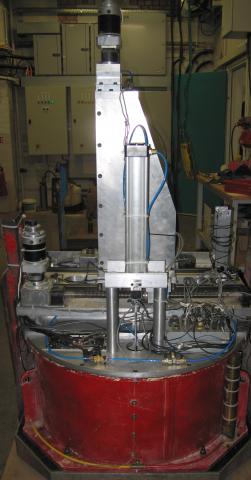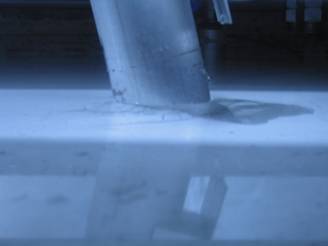
Centrifuge modelling involves testing of small scale models in the enhanced gravity field of a geotechnical  centrifuge. This technique is particularly useful in testing materials such as soils which exhibit non-linear stress-strain behaviour and can suffer significant plastic strains. Centrifuge modelling is proven to be particularly effective in determining the failure mechanisms for a wide variety of geotechnical problems.
centrifuge. This technique is particularly useful in testing materials such as soils which exhibit non-linear stress-strain behaviour and can suffer significant plastic strains. Centrifuge modelling is proven to be particularly effective in determining the failure mechanisms for a wide variety of geotechnical problems.
The Cambridge geotechnical group is at the forefront of the geotechnical research using centrifuge modelling. Recent additions to our equipment such as the 2-D robotic actuator that can apply large axial and lateral loads to monopiles while flying in a 100g test, enable us to carryout cutting edge research on the long term behaviour of offshore monopile foundations.
This project is possible due to the generous support of the EPSRC Grant (EP/H013857/1) on Cyclic behaviour of monopile foundations for offshore wind farms. This project benefits from the previous Platform Grant (GR/T18660/01) and SRIF-3 funding from HEFCE that allowed us to develop the 2-D robotic actuator and other facilities. The computer controlled 2-D actuator that is able to install monopile foundations in-flight and to subject them simultaneously to axial, cyclic lateral and moment loading. This actuator can be mounted on an 850mm diameter centrifuge model container containing pre-consolidated clay layers of desired thickness, soil stratification and strength profile (up to 300mm to represent a 30m clay stratum in the field in a 100 gravities centrifuge test). The 2-D actuator has been designed to withstand 100g of centrifugal acceleration, it can apply a maximum axial load of 10 kN and a maximum horizontal load of 5 kN. In a 100g centrifuge test these forces represent 100 MN (axial load) and 50 MN (lateral load) respectively. In addition, the horizontal load of 5 kN can be applied at any height of up to 0.4m above the top of the monopile to create a maximum moment load of 2 kNm. The actuator is computer controlled to enable either force control or displacement control. It can apply cyclic loads in both axial and lateral directions giving us the ability to apply many cycles of fixed force amplitude (or fixed displacement amplitude) in the lateral direction, while applying a constant vertical load.
